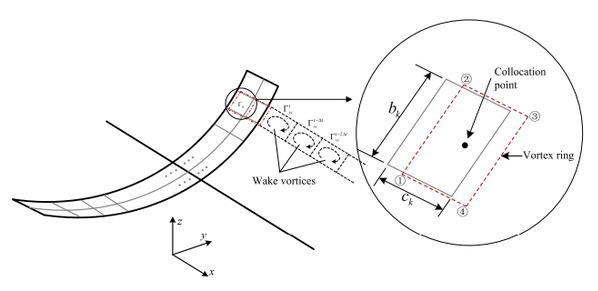Abstract
The unsteady vortex-lattice method provides a medium-fidelity tool for calculation of low-speed aerodynamic loads based on the potential-flow theory. It has long been favored in research on the aeroelasticity and flight dynamics for flexible aircraft with high aspect ratios. However, the unsteady vortex-lattice method is established in the discrete time domain which brings difficulties to modeling aeroelastic system for stability analysis. An analytical aerodynamic sensitivity calculation scheme is developed in this paper to formulate the aeroelastic equations of motion with UVLM aerodynamics. A free wake model is used to simulate accurate vortex shedding and subsequent wake propagation. Using a small perturbation method, the aerodynamic governing equations are linearized around the equilibrium condition, where the analytical sensitivities can be derived. The surface spline interpolation algorithm is adopted to implement the structure-aerodynamic coupling. Both aerodynamic sensitivities with respect to structural motions and circulation strengths of vortices are obtained. In numerical studies, a timemarching transient response analysis scheme is used to obtain the distributed aerodynamic loads and structural deformations. Analytical sensitivity results are validated by the finite difference method. The proposed analytical sensitivity calculation framework is demonstrated to be applicable to commonly used beam-based flexible wing models, as well as the shell-based finite element models with higher fidelity. The derived sensitivity formulations and related numerical implementations can build the foundation for further studies on aeroelastic optimization and stability analysis.

Fig. Boundary vortex rings on the lifting surface and the free wake model
原文链接:http://doi.org/10.1016/j.ast.2019.105612


